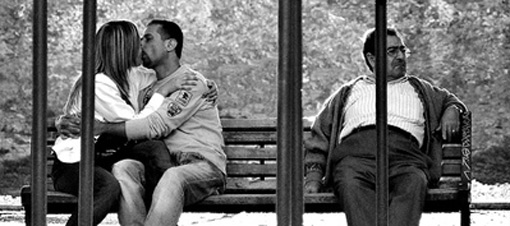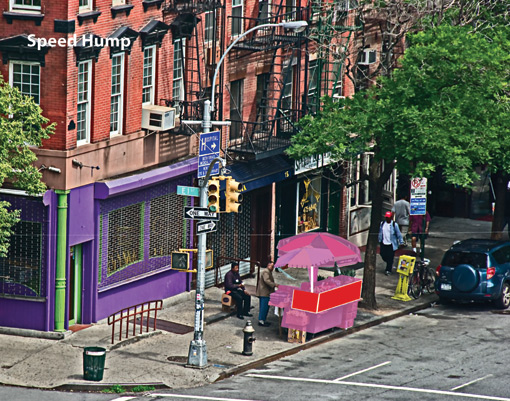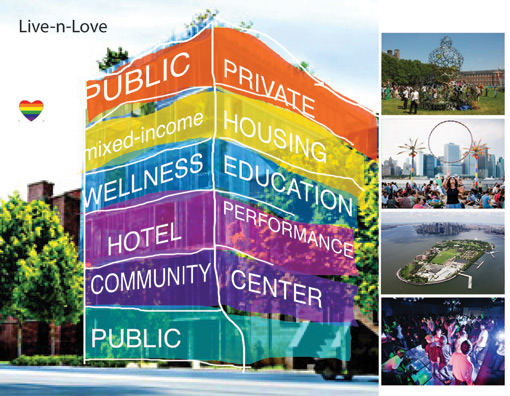Public Sex
Posted on December 20, 2010 | posted by:
Photo courtesy of inlibertyvillage.com
Sex in public spaces isn’t far from anyone’s imagination, particularly in New York City . It’s not odd to hear bar stories of sexual encounters in a public park, an elevator, a subway car, an airplane bathroom, or a rooftop. How do we draw the lines from socially acceptable public displays of affection to what’s completely unacceptable or perverse? How might we imagine ourselves as society where sexual expressions and experiences are tolerated, where gender diversity and eroticism is celebrated? How far could we go, in pushing sexuality in the public realm? These were some initial questions we explored through our investigation of the infrastructure of sex, and the answers are, well…a bit complicated. The thrust of our project was to somehow counteract the “taboo“ qualities of physical sex infrastructure, namely the red light districts, the XXX video stores, etc. More importantly our aim was to dispel the notions of guilt and shame, which are commonly associated with sex by introducing a positive notion of human sexuality directly into the urban fabric.
Getting Dirty
We imagined ways of introducing ‘sex positivity’ into visible and physical realms of the city infrastructure, only to encounter a great amount of red-tape. This mapping exercise displays the restricted zones that that we encountered, showing areas of prohibition and surveillance. With this, a number of laws would prevent us from full implementation of any of our ideas without significant attenuation. It seemed contradictory in many ways. We are a sexually liberated society, or at least the prevalence of sexually-titilating media suggests. We have one of the most active and open gay-rights movements in the world along with an emergence and openness to a variety of sexual practices.
Three Scales of Intervention
Speed Hump – Imagine your local fruit vendor, whom you see daily on your commute to and from work, but along with the fruit (and chocolate), there is a tableaux of sex toys, protection, literature, and romantic gifts. Healthy and safe sex can and should be a part of the everyday.
Not-So-Secret Garden – A semi-private urban oasis for lovers. A “Birds and Bees” community center looks after the young ones while couples venture into a private oasis. The small center provides possible programming for light programming and community partnerships.
Sex Center – A nexus for experts from every sex-related public realm can convene, discuss, teach, learn, and practice elements of sex positivity with the community and civic leaders who work in the realm of human sexuality. Programmed spaces could include educational and training center, hotel and conferencing, film/media, gallery/exhibit space, and rooftop garden.
What is Normal?
Society’s increasing pluralism and heterogeneity leads to mixed or divergent views on sexuality. Misinterpretations can breed ignorance. Ignorance can lead to discrimination and violence, thus, it is apparent that the public realm provide representation and sanctuary for those who are in risk of being discriminated against. Raising awareness of sexual issues across disciplines in education, health, science and psychology is absolutely necessary in order to understanding how to discuss the varying sensitivities each individual may experience.
Sigmund Freud spoke of his opposition to a “civilized sexual morality” and its negative effects to the human psyche of human madness. In modern day terms civilized sexual morality is now called heteronormativity, and its relative – homonormativity. The manner in which these words can be used within the justice system and in everyday practice raise many questions and concerns, as they reinforce negative stereotypes. Bias and ambiguity are simply unjust; and the role of communication in the construction and performance of sexualities in interpersonal contexts is increasingly important. One must ask, is there such a thing as sexual normalcy today?
The fabric of society tends to hide the right of sexual expression in its folds thanks to an array of historically ingrained negative emotions: embarrassment, shame, humiliation, feelings of vulnerability, fear, disgust, and moral indignation. Indeed, the very thought of erotic diversity commonly generates considerable anger, disgust, and moral condemnation. In most cultures, the official lip service is more likely to take the form of denunciation rather than praise. The paradox necessarily continues, for the rhetoric of human sexuality is not complete without controversy.
Minuette Le and Jayson Rupert


